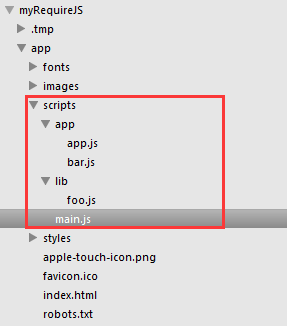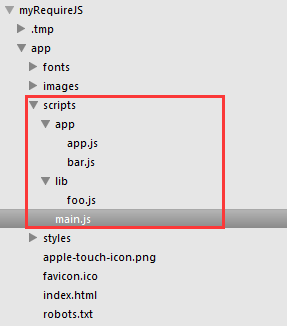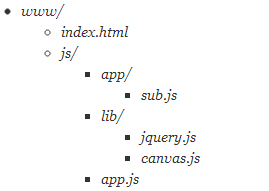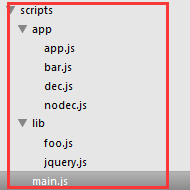 Web Front-end
Web Front-end
 JS Tutorial
JS Tutorial
 One article to master common knowledge of RequireJS_javascript skills
One article to master common knowledge of RequireJS_javascript skills
One article to master common knowledge of RequireJS_javascript skills
This article adopts a step-by-step approach, from theory to practice. From the RequireJS official API document, it summarizes some of the most commonly used usages in the process of using RequireJS, and provides examples and analysis for the content that is not clear and specific in the document, and shares it. For your reference, the specific content is as follows
1. Modularity
I believe that every front-end developer has written code similar to the following style when he first came into contact with js programming:
<script type="text/javascript">
var a = 1;
var b = 2;
var c = a * a + b * b;
if(c> 1) {
alert('c > 1');
}
function add(a, b) {
return a + b;
}
c = add(a,b);
</script>
<a href="javascript:;" onclick="click(this);" title="">请点击</a>
The characteristics of these codes are:
- Global variables found everywhere
- Lots of functions
- Various js calls embedded on html elements
Of course, there is nothing wrong with the functions of these codes themselves, but in terms of code reusability, robustness and maintainability, this programming method is problematic, especially in applications with more complex page logic. , these problems will be particularly obvious:
- Global variables can easily cause naming conflicts
- Functional programming is very unfavorable to the organization and management of code
- Embedded js calls are not conducive to code maintenance, because the html code is sometimes very bloated and huge
So when these problems appeared, js experts began to look for the ultimate solution to these problems, so modular development appeared. Just as the surface meaning of the concept of modularization is the same, it requires that when writing code, independent logic should be encapsulated into reusable modules by level and function, and a direct and clear calling interface should be provided externally, and the internal implementation details should be completely private. Moreover, the internal implementations between modules do not interfere with each other during execution. The final result is that the problems mentioned in the previous examples can be solved. An example written simply following modular development requirements:
//module.js
var student = function (name) {
return name && {
getName: function () {
return name;
}
};
},
course = function (name) {
return name && {
getName: function () {
return name;
}
}
},
controller = function () {
var data = {};
return {
add: function (stu, cour) {
var stuName = stu && stu.getName(),
courName = cour && cour.getName(),
current,
_filter = function (e) {
return e === courName;
};
if (!stuName || !courName) return;
current = data[stuName] = data[stuName] || [];
if (current.filter(_filter).length === 0) {
current.push(courName);
}
},
list: function (stu) {
var stuName = stu && stu.getName(),
current = data[stuName];
current && console.log(current.join(';'));
}
}
};
//main.js
var stu = new student('lyzg'),
c = new controller();
c.add(stu,new course('javascript'));
c.add(stu,new course('html'));
c.add(stu,new course('css'));
c.list(stu);
The above code defines three modules to represent students, courses and controllers respectively, and then calls the add and list interfaces provided by the controller in main.js to add three courses to the student lyzg, and then displays them on the console out. The running results are as follows:
javascript;html;css
Through the above example, we can see that the modular code structure and logic are very clear, and the code looks very elegant. In addition, because the logic is split through modules, the purpose of decoupling is achieved, and the function of the code will be relatively robust. . However, the modular development method used in the above example is not without problems. The problem is that it still adds module references such as student directly to the global space. Although many variables and functions in the global space are reduced through modules, the module The reference itself still depends on the global space before it can be called. When there are many modules or third-party module libraries are introduced, naming conflicts may still occur. Therefore, this modular development method in the global space is not the most perfect. way. Among the currently common modular development methods, the global space method is the most basic one. In addition, the development methods that follow AMD specifications, the development methods that follow CMD specifications, and the ECMAScript 6 development method are also common. It should be noted that CMD and ES6 have nothing to do with the core of this article, so they will not be introduced here. The following content mainly introduces AMD and RequireJS that implements the AMD specification.
2. AMD specifications
As mentioned above, another common way to achieve modular development is to follow the AMD specification. However, the AMD specification is not a specific implementation method, but just a solution for modular development. You can Think of it as some interface declarations for modular development. If you want to implement a modular development tool that follows this specification, you must implement its predefined API. For example, it requires that when loading a module, the following API calling method must be used:
require([module], callback) 其中: [module]:是一个数组,里面的成员就是要加载的模块; callback:是模块加载完成之后的回调函数
所有遵循AMD规范的模块化工具,都必须按照它的要求去实现,比如RequireJS这个库,就是完全遵循AMD规范实现的,所以在利用RequireJS加载或者调用模块时,如果你事先知道AMD规范的话,你就知道该怎么用RequireJS了。规范的好处在于,不同的实现却有相同的调用方式,很容易切换不同的工具使用,至于具体用哪一个实现,这就跟各个工具的各自的优点跟项目的特点有关系,这些都是在项目开始选型的时候需要确定的。目前RequireJS不是唯一实现了AMD规范的库,像Dojo这种更全面的js库也都有AMD的实现。
最后对AMD全称做一个解释,译为:异步模块定义。异步强调的是,在加载模块以及模块所依赖的其它模块时,都采用异步加载的方式,避免模块加载阻塞了网页的渲染进度。相比传统的异步加载,AMD工具的异步加载更加简便,而且还能实现按需加载,具体解释在下一部分说明。
3. JavaScript的异步加载和按需加载
html中的script标签在加载和执行过程中会阻塞网页的渲染,所以一般要求尽量将script标签放置在body元素的底部,以便加快页面显示的速度,还有一种方式就是通过异步加载的方式来加载js,这样可以避免js文件对html渲染的阻塞。
第1种异步加载的方式是直接利用脚本生成script标签的方式:
(function() {
var s = document.createElement('script');
s.type = 'text/javascript';
s.async = true;
s.src = 'http://yourdomain.com/script.js';
var x = document.getElementsByTagName('script')[0];
x.parentNode.insertBefore(s, x);
})();
这段代码,放置在script标记内部,然后该script标记添加到body元素的底部即可。
第2种方式是借助script的属性:defer和async,defer这个属性在IE浏览器和早起的火狐浏览器中支持,async在支持html5的浏览器上都支持,只要有这两个属性,script就会以异步的方式来加载,所以script在html中的位置就不重要了:
<script defer async="true" type="text/javascript" src="app/foo.js"></script> <script defer async="true" type="text/javascript" src="app/bar.js"></script> <script defer async="true" type="text/javascript" src="app/main.js"></script>
这种方式下,所有异步js在执行的时候还是按顺序执行的,不然就会存在依赖问题,比如如果上例中的main.js依赖foo.js和bar.js,但是main.js先执行的话就会出错了。虽然从来理论上这种方式也算不错了,但是不够好,因为它用起来很繁琐,而且还有个问题就是页面需要添加多个script标记以及没有办法完全做到按需加载。
JS的按需加载分两个层次,第一个层次是只加载这个页面可能被用到的JS,第二个层次是在只在用到某个JS的时候才去加载。传统地方式很容易做到第一个层次,但是不容易做到第二个层次,虽然我们可以通过合并和压缩工具,将某个页面所有的JS都添加到一个文件中去,最大程度减少资源请求量,但是这个JS请求到客户端以后,其中有很多内容可能都用不上,要是有个工具能够做到在需要的时候才去加载相关js就完美解决问题了,比如RequireJS。
4. RequireJS常用用法总结
前文多次提及RequireJS,本部分将对它的常用用法详细说明,它的官方地址是:http://www.requirejs.cn/,你可以到该地址去下载最新版RequireJS文件。RequireJS作为目前使用最广泛的AMD工具,它的主要优点是:
- 完全支持模块化开发
- 能将非AMD规范的模块引入到RequireJS中使用
- 异步加载JS
- 完全按需加载依赖模块,模块文件只需要压缩混淆,不需要合并
- 错误调试
- 插件支持
4.01 如何使用RequireJS
使用方式很简单,只要一个script标记就可以在网页中加载RequireJS:
<script defer async="true" src="/bower_components/requirejs/require.js"></script>
由于这里用到了defer和async这两个异步加载的属性,所以require.js是异步加载的,你把这个script标记放置在任何地方都没有问题。
4.02 如何利用RequireJS加载并执行当前网页的逻辑JS
4.01解决的仅仅是RequireJS的使用问题,但它仅仅是一个JS库,是一个被当前页面的逻辑所利用的工具,真正实现网页功能逻辑的是我们要利用RequireJS编写的主JS,这个主JS(假设这些代码都放置在main.js文件中)又该如何利用RJ来加载执行呢?方式如下:
<script data-main="scripts/main.js" defer async="true" src="/bower_components/requirejs/require.js"></script>
对比4.01,你会发现script标记多了一个data-main,RJ用这个配置当前页面的主JS,你要把逻辑都写在这个main.js里面。当RJ自身加载执行后,就会再次异步加载main.js。这个main.js是当前网页所有逻辑的入口,理想情况下,整个网页只需要这一个script标记,利用RJ加载依赖的其它文件,如jquery等。
4.03 main.js怎么写
假设项目的目录结构为:

main.js是跟当前页面相关的主JS,app文件夹存放本项目自定义的模块,lib存放第三方库。
html中按4.02的方式配置RJ。main.js的代码如下:
require(['lib/foo', 'app/bar', 'app/app'], function(foo, bar, app) {
//use foo bar app do sth
});
在这段JS中,我们利用RJ提供的require方法,加载了三个模块,然后在这个三个模块都加载成功之后执行页面逻辑。require方法有2个参数,第一个参数是数组类型的,实际使用时,数组的每个元素都是一个模块的module ID,第二个参数是一个回调函数,这个函数在第一个参数定义的所有模块都加载成功后回调,形参的个数和顺序分别与第一个参数定义的模块对应,比如第一个模块时lib/foo,那么这个回调函数的第一个参数就是foo这个模块的引用,在回调函数中我们使用这些形参来调用各个模块的方法,由于回调是在各模块加载之后才调用的,所以这些模块引用肯定都是有效的。
从以上这个简短的代码,你应该已经知道该如何使用RJ了。
4.04 RJ的baseUrl和module ID
在介绍RJ如何去解析依赖的那些模块JS的路径时,必须先弄清楚baseUrl和module ID这两个概念。
html中的base元素可以定义当前页面内部任何http请求的url前缀部分,RJ的baseUrl跟这个base元素起的作用是类似的,由于RJ总是动态地请求依赖的JS文件,所以必然涉及到一个JS文件的路径解析问题,RJ默认采用一种baseUrl + moduleID的解析方式,这个解析方式后续会举例说明。这个baseUrl非常重要,RJ对它的处理遵循如下规则:
- 在没有使用data-main和config的情况下,baseUrl默认为当前页面的目录
- 在有data-main的情况下,main.js前面的部分就是baseUrl,比如上面的scripts/
- 在有config的情况下,baseUrl以config配置的为准
上述三种方式,优先级由低到高排列。
data-main的使用方式,你已经知道了,config该如何配置,如下所示:
require.config({
baseUrl: 'scripts'
});这个配置必须放置在main.js的最前面。data-main与config配置同时存在的时候,以config为准,由于RJ的其它配置也是在这个位置配置的,所以4.03中的main.js可以改成如下结构,以便将来的扩展:
require.config({
baseUrl: 'scripts'
});
require(['lib/foo', 'app/bar', 'app/app'], function(foo, bar, app) {
// use foo bar app do sth
});
关于module ID,就是在require方法以及后续的define方法里,用在依赖数组这个参数里,用来标识一个模块的字符串。上面代码中的['lib/foo', 'app/bar', 'app/app']就是一个依赖数组,其中的每个元素都是一个module ID。值得注意的是,module ID并不一定是该module 相关JS路径的一部分,有的module ID很短,但可能路径很长,这跟RJ的解析规则有关。下一节详细介绍。
4.05 RJ的文件解析规则
RJ默认按baseUrl + module ID的规则,解析文件,并且它默认要加载的文件都是js,所以你的module ID里面可以不包含.js的后缀,这就是为啥你看到的module ID都是lib/foo, app/bar这种形式了。有三种module ID,不适用这种规则:
- 以/开头,如/lib/jquey.js
- 以.js结尾,如test.js
- 包含http或https,如http://xx.baidu.com/js/jquery.js
假如main.js如下使用:
require.config({
baseUrl: 'scripts'
});
require(['/lib/foo', 'test.js', '/js/jquery'], function(foo, bar, app) {
// use foo bar app do sth
});
这三个module 都不会根据baseUrl + module ID的规则来解析,而是直接用module ID来解析,等效于下面的代码:
<script src="/lib/foo.js"></script> <script src="test.js"></script> <script src="/js/jquery.js"></script>
各种module ID解析举例:
例1,项目结构如下:

main.js如下:
require.config({
baseUrl: 'scripts'
});
require(['lib/foo', 'app/bar', 'app/app'], function(foo, bar, app) {
// use foo bar app do sth
});
baseUrl为:scripts目录
moduleID为:lib/foo, app/bar, app/app
根据baseUrl + moduleID,以及自动补后缀.js,最终这三个module的js文件路径为:
scripts/lib/foo.js scripts/app/bar.js scripts/app/app.js
例2,项目结构同例1:
main.js改为:
require.config({
baseUrl: 'scripts/lib',
paths: {
app: '../app'
}
});
require(['foo', 'app/bar', 'app/app'], function(foo, bar, app) {
// use foo bar app do sth
});
这里出现了一个新的配置paths,它的作用是针对module ID中特定的部分,进行转义,如以上代码中对app这个部分,转义为../app,这表示一个相对路径,相对位置是baseUrl所指定的目录,由项目结构可知,../app其实对应的是scirpt/app目录。正因为有这个转义的存在,所以以上代码中的app/bar才能被正确解析,否则还按baseUrl + moduleID的规则,app/bar不是应该被解析成scripts/lib/app/bar.js吗,但实际并非如此,app/bar被解析成scripts/app/bar.js,其中起关键作用的就是paths的配置。通过这个举例,可以看出module ID并不一定是js文件路径中的一部分,paths的配置对于路径过程的js特别有效,因为可以简化它的module ID。
另外第一个模块的ID为foo,同时没有paths的转义,所以根据解析规则,它的文件路径时:scripts/lib/foo.js。
paths的配置中只有当模块位于baseUrl所指定的文件夹的同层目录,或者更上层的目录时,才会用到../这种相对路径。
例3,项目结果同例1,main.js同例2:
这里要说明的问题稍微特殊,不以main.js为例,而以app.js为例,且app依赖bar,当然config还是需要在main.js中定义的,由于这个问题在定义模块的时候更加常见,所以用define来举例,假设app.js模块如下定义:
define(['./bar'], function(bar) {
return {
doSth: function() {
bar.doSth();
}
}
});
上面的代码通过define定义了一个模块,这个define函数后面介绍如何定义模块的时候再来介绍,这里简单了解。这里这种用法的第一个参数跟require函数一样,是一个依赖数组,第二个参数是一个回调,也是在所有依赖加载成功之后调用,这个回调的返回值会成为这个模块的引用被其它模块所使用。
这里要说的问题还是跟解析规则相关的,如果完全遵守RJ的解析规则,这里的依赖应该配置成app/bar才是正确的,但由于app.js与bar.js位于同一个目录,所以完全可利用./这个同目录的相对标识符来解析js,这样的话只要app.js已经加载成功了,那么去同目录下找bar.js就肯定能找到了。这种配置在定义模块的时候非常有意义,这样你的模块就不依赖于放置这些模块的文件夹名称了。
4.06 RJ的异步加载
RJ不管是require方法还是define方法的依赖模块都是异步加载的,所以下面的代码不一定能解析到正确的JS文件:
<script data-main="scripts/main" src="scripts/require.js"></script>
<script src="scripts/other.js"></script>
//main.js
require.config({
paths: {
foo: 'libs/foo-1.1.3'
}
});
//other.js
require( ['foo'], function( foo ) {
//foo is undefined
});
由于main.js是异步加载的,所以other.js会比它先加载,但是RJ的配置存在于main.js里面,所以在加载other.js读不到RJ的配置,在other.js执行的时候解析出来的foo的路径就会变成scripts/foo.js,而正确路径应该是scripts/libs/foo-1.1.3.js。
尽管RJ的依赖是异步加载的,但是已加载的模块在多次依赖的时候,不会再重新加载:
define(['require', 'app/bar', 'app/app'], function(require) {
var bar= require("app/bar");
var app= require("app/app");
//use bar and app do sth
});
上面的代码,在callback定义的时候,只用了一个形参,这主要是为了减少形参的数量,避免整个回调的签名很长。依赖的模块在回调内部可以直接用require(moduleID)的参数得到,由于在回调执行前,依赖的模块已经加载,所以此处调用不会再重新加载。但是如果此处获取一个并不在依赖数组中出现的module ID,require很有可能获取不到该模块引用,因为它可能需要重新加载,如果它没有在其它模块中被加载过的话。
4.07 RJ官方推荐的JS文件组织结构
RJ建议,文件组织尽量扁平,不要多层嵌套,最理想的是跟项目相关的放在一个文件夹,第三方库放在一个文件夹,如下所示:

4.08 使用define定义模块
AMD规定的模块定义规范为:
define(id?, dependencies?, factory); 其中: id: 模块标识,可以省略。 dependencies: 所依赖的模块,可以省略。 factory: 模块的实现,或者一个JavaScript对象
关于第一个参数,本文不会涉及,因为RJ建议所有模块都不要使用第一个参数,如果使用第一个参数定义的模块成为命名模块,不适用第一个参数的模块成为匿名模块,命名模块如果更名,所有依赖它的模块都得修改!第二个参数是依赖数组,跟require一样,如果没有这个参数,那么定义的就是一个无依赖的模块;最后一个参数是回调或者是一个简单对象,在模块加载完毕后调用,当然没有第二个参数,最后一个参数也会调用。
本部分所举例都采用如下项目结构:

1. 定义简单对象模块:
app/bar.js
define({
bar:'I am bar.'
});
利用main.js测试:
require.config({
baseUrl: 'scripts/lib',
paths: {
app: '../app'
}
});
require(['app/bar'], function(bar) {
console.log(bar);// {bar: 'I am bar.'}
});
2. 定义无依赖的模块:
app/nodec.js:
define(function () {
return {
nodec: "yes, I don't need dependence."
}
});
利用main.js测试:
require.config({
baseUrl: 'scripts/lib',
paths: {
app: '../app'
}
});
require(['app/nodec'], function(nodec) {
console.log(nodec);// {nodec: yes, I don't need dependence.'}
});
3. 定义依赖其它模块的模块:
app/dec.js:
define(['jquery'], function($){
//use $ do sth ...
return {
useJq: true
}
});
利用main.js测试:
require.config({
baseUrl: 'scripts/lib',
paths: {
app: '../app'
}
});
require(['app/dec'], function(dec) {
console.log(dec);//{useJq: true}
});
4. 循环依赖:
当一个模块foo的依赖数组中存在bar,bar模块的依赖数组中存在foo,就会形成循环依赖,稍微修改下bar.js和foo.js如下。
app/bar.js:
define(['foo'],function(foo){
return {
name: 'bar',
hi: function(){
console.log('Hi! ' + foo.name);
}
}
});
lib/foo.js:
define(['app/bar'],function(bar){
return {
name: 'foo',
hi: function(){
console.log('Hi! ' + bar.name);
}
}
});
利用main.js测试:
require.config({
baseUrl: 'scripts/lib',
paths: {
app: '../app'
}
});
require(['app/bar', 'foo'], function(bar, foo) {
bar.hi();
foo.hi();
});
运行结果:

如果改变main.js中require部分的依赖顺序,结果:

循环依赖导致两个依赖的module之间,始终会有一个在获取另一个的时候,得到undefined。解决方法是,在定义module的时候,如果用到循环依赖的时候,在define内部通过require重新获取。main.js不变,bar.js改成:
define(['require', 'foo'], function(require, foo) {
return {
name: 'bar',
hi: function() {
foo = require('foo');
console.log('Hi! ' + foo.name);
}
}
});
foo.js改成:
define(['require', 'app/bar'], function(require, bar) {
return {
name: 'foo',
hi: function() {
bar = require('app/bar');
console.log('Hi! ' + bar.name);
}
}
});
利用上述代码,重新执行,结果是:

模块定义总结:不管模块是用回调函数定义还是简单对象定义,这个模块输出的是一个引用,所以这个引用必须是有效的,你的回调不能返回undefined,但是不局限于对象类型,还可以是数组,函数,甚至是基本类型,只不过如果返回对象,你能通过这个对象组织更多的接口。
4.09 内置的RJ模块
再看看这个代码:
define(['require', 'app/bar'], function(require) {
return {
name: 'foo',
hi: function() {
var bar = require('app/bar');
console.log('Hi! ' + bar.name);
}
}
});
依赖数组中的require这个moduleID对应的是一个内置模块,利用它加载模块,怎么用你已经看到了,比如在main.js中,在define中。另外一个内置模块是module,这个模块跟RJ的另外一个配置有关,具体用法请在第5大部分去了解。
4.10 其它RJ有用功能
1. 生成相对于模块的URL地址
define(["require"], function(require) {
var cssUrl = require.toUrl("./style.css");
});
这个功能在你想要动态地加载一些文件的时候有用,注意要使用相对路径。
2. 控制台调试
require("module/name").callSomeFunction()
假如你想在控制台中查看某个模块都有哪些方法可以调用,如果这个模块已经在页面加载的时候通过依赖被加载过后,那么就可以用以上代码在控制台中做各种测试了。
5. RequireJS常用配置总结
在RJ的配置中,前面已经接触到了baseUrl,paths,另外几个常用的配置是:
- shim
- config
- enforceDefine
- urlArgs
5.01 shim
为那些没有使用define()来声明依赖关系、设置模块的"浏览器全局变量注入"型脚本做依赖和导出配置。
例1:利用exports将模块的全局变量引用与RequireJS关联
main.js如下:
require.config({
baseUrl: 'scripts/lib',
paths: {
app: '../app'
},
shim: {
underscore: {
exports: '_'
}
}
});
require(['underscore'], function(_) {
// 现在可以通过_调用underscore的api了
});
如你所见,RJ在shim中添加了一个对underscore这个模块的配置,并通过exports属性指定该模块暴露的全局变量,以便RJ能够对这些模块统一管理。
例2:利用deps配置js模块的依赖
main.js如下:
require.config({
baseUrl: 'scripts/lib',
paths: {
app: '../app'
},
shim: {
backbone: {
deps: ['underscore', 'jquery'],
exports: 'Backbone'
}
}
});
require(['backbone'], function(Backbone) {
//use Backbone's API
});
由于backbone这个组件依赖jquery和underscore,所以可以通过deps属性配置它的依赖,这样backbone将会在另外两个模块加载完毕之后才会加载。
例3:jquery等库插件配置方法
代码举例如下:
requirejs.config({
shim: {
'jquery.colorize': {
deps: ['jquery'],
exports: 'jQuery.fn.colorize'
},
'jquery.scroll': {
deps: ['jquery'],
exports: 'jQuery.fn.scroll'
},
'backbone.layoutmanager': {
deps: ['backbone']
exports: 'Backbone.LayoutManager'
}
}
});
5.02 config
常常需要将配置信息传给一个模块。这些配置往往是application级别的信息,需要一个手段将它们向下传递给模块。在RequireJS中,基于requirejs.config()的config配置项来实现。要获取这些信息的模块可以加载特殊的依赖“module”,并调用module.config()。
例1:在requirejs.config()中定义config,以供其它模块使用
requirejs.config({
config: {
'bar': {
size: 'large'
},
'baz': {
color: 'blue'
}
}
});
如你所见,config属性中的bar这一节是在用于module ID为bar这个模块的,baz这一节是用于module ID为baz这个模块的。具体使用以bar.js举例:
define(['module'], function(module) {
//Will be the value 'large'var size = module.config().size;
});
前面提到过,RJ的内置模块除了require还有一个module,用法就在此处,通过它可以来加载config的内容。
5.03 enforceDefine
如果设置为true,则当一个脚本不是通过define()定义且不具备可供检查的shim导出字串值时,就会抛出错误。这个属性可以强制要求所有RJ依赖或加载的模块都要通过define或者shim被RJ来管理,同时它还有一个好处就是用于错误检测。
5.04 urlArgs
RequireJS获取资源时附加在URL后面的额外的query参数。作为浏览器或服务器未正确配置时的“cache bust”手段很有用。使用cache bust配置的一个示例:
urlArgs: "bust=" + (new Date()).getTime()
6. 错误处理
6.01 加载错误的捕获
IE中捕获加载错误不完美:
IE 6-8中的script.onerror无效。没有办法判断是否加载一个脚本会导致404错;更甚地,在404中依然会触发state为complete的onreadystatechange事件。
IE 9+中script.onerror有效,但有一个bug:在执行脚本之后它并不触发script.onload事件句柄。因此它无法支持匿名AMD模块的标准方法。所以script.onreadystatechange事件仍被使用。但是,state为complete的onreadystatechange事件会在script.onerror函数触发之前触发。
所以为了支持在IE中捕获加载错误,需要配置enforceDefine为true,这不得不要求你所有的模块都用define定义,或者用shim配置RJ对它的引用。
注意:如果你设置了enforceDefine: true,而且你使用data-main=""来加载你的主JS模块,则该主JS模块必须调用define()而不是require()来加载其所需的代码。主JS模块仍然可调用require/requirejs来设置config值,但对于模块加载必须使用define()。比如原来的这段就会报错:
require.config({
enforceDefine: true,
baseUrl: 'scripts/lib',
paths: {
app: '../app'
},
shim: {
backbone: {
deps: ['underscore', 'jquery'],
exports: 'Backbone'
}
}
});
require(['backbone'], function(Backbone) {
console.log(Backbone);
});
把最后三行改成:
define(['backbone'], function(Backbone) {
console.log(Backbone);
});
才不会报错。
6.02 paths备错
requirejs.config({
//To get timely, correct error triggers in IE, force a define/shim exports check.
enforceDefine: true,
paths: {
jquery: [
'http://ajax.googleapis.com/ajax/libs/jquery/1.4.4/jquery.min',
//If the CDN location fails, load from this location
'lib/jquery'
]
}
});
//Later
require(['jquery'], function ($) {
});
上述代码先尝试加载CDN版本,如果出错,则退回到本地的lib/jquery.js。
注意: paths备错仅在模块ID精确匹配时工作。这不同于常规的paths配置,常规配置可匹配模块ID的任意前缀部分。备错主要用于非常的错误恢复,而不是常规的path查找解析,因为那在浏览器中是低效的。
6.03 全局 requirejs.onError
为了捕获在局域的errback中未捕获的异常,你可以重载requirejs.onError():
requirejs.onError = function (err) {
console.log(err.requireType);
if (err.requireType === 'timeout') {
console.log('modules: ' + err.requireModules);
}
throw err;
};
以上就是本文的全部内容,希望对大家的学习有所帮助。

Hot AI Tools

Undresser.AI Undress
AI-powered app for creating realistic nude photos

AI Clothes Remover
Online AI tool for removing clothes from photos.

Undress AI Tool
Undress images for free

Clothoff.io
AI clothes remover

AI Hentai Generator
Generate AI Hentai for free.

Hot Article

Hot Tools

Notepad++7.3.1
Easy-to-use and free code editor

SublimeText3 Chinese version
Chinese version, very easy to use

Zend Studio 13.0.1
Powerful PHP integrated development environment

Dreamweaver CS6
Visual web development tools

SublimeText3 Mac version
God-level code editing software (SublimeText3)

Hot Topics
 1376
1376
 52
52
 Replace String Characters in JavaScript
Mar 11, 2025 am 12:07 AM
Replace String Characters in JavaScript
Mar 11, 2025 am 12:07 AM
Detailed explanation of JavaScript string replacement method and FAQ This article will explore two ways to replace string characters in JavaScript: internal JavaScript code and internal HTML for web pages. Replace string inside JavaScript code The most direct way is to use the replace() method: str = str.replace("find","replace"); This method replaces only the first match. To replace all matches, use a regular expression and add the global flag g: str = str.replace(/fi
 How do I create and publish my own JavaScript libraries?
Mar 18, 2025 pm 03:12 PM
How do I create and publish my own JavaScript libraries?
Mar 18, 2025 pm 03:12 PM
Article discusses creating, publishing, and maintaining JavaScript libraries, focusing on planning, development, testing, documentation, and promotion strategies.
 How do I optimize JavaScript code for performance in the browser?
Mar 18, 2025 pm 03:14 PM
How do I optimize JavaScript code for performance in the browser?
Mar 18, 2025 pm 03:14 PM
The article discusses strategies for optimizing JavaScript performance in browsers, focusing on reducing execution time and minimizing impact on page load speed.
 How do I debug JavaScript code effectively using browser developer tools?
Mar 18, 2025 pm 03:16 PM
How do I debug JavaScript code effectively using browser developer tools?
Mar 18, 2025 pm 03:16 PM
The article discusses effective JavaScript debugging using browser developer tools, focusing on setting breakpoints, using the console, and analyzing performance.
 10 Ways to Instantly Increase Your jQuery Performance
Mar 11, 2025 am 12:15 AM
10 Ways to Instantly Increase Your jQuery Performance
Mar 11, 2025 am 12:15 AM
This article outlines ten simple steps to significantly boost your script's performance. These techniques are straightforward and applicable to all skill levels. Stay Updated: Utilize a package manager like NPM with a bundler such as Vite to ensure
 Using Passport With Sequelize and MySQL
Mar 11, 2025 am 11:04 AM
Using Passport With Sequelize and MySQL
Mar 11, 2025 am 11:04 AM
Sequelize is a promise-based Node.js ORM. It can be used with PostgreSQL, MySQL, MariaDB, SQLite, and MSSQL. In this tutorial, we will be implementing authentication for users of a web app. And we will use Passport, the popular authentication middlew
 How to Build a Simple jQuery Slider
Mar 11, 2025 am 12:19 AM
How to Build a Simple jQuery Slider
Mar 11, 2025 am 12:19 AM
This article will guide you to create a simple picture carousel using the jQuery library. We will use the bxSlider library, which is built on jQuery and provides many configuration options to set up the carousel. Nowadays, picture carousel has become a must-have feature on the website - one picture is better than a thousand words! After deciding to use the picture carousel, the next question is how to create it. First, you need to collect high-quality, high-resolution pictures. Next, you need to create a picture carousel using HTML and some JavaScript code. There are many libraries on the web that can help you create carousels in different ways. We will use the open source bxSlider library. The bxSlider library supports responsive design, so the carousel built with this library can be adapted to any
 How do I use source maps to debug minified JavaScript code?
Mar 18, 2025 pm 03:17 PM
How do I use source maps to debug minified JavaScript code?
Mar 18, 2025 pm 03:17 PM
The article explains how to use source maps to debug minified JavaScript by mapping it back to the original code. It discusses enabling source maps, setting breakpoints, and using tools like Chrome DevTools and Webpack.



